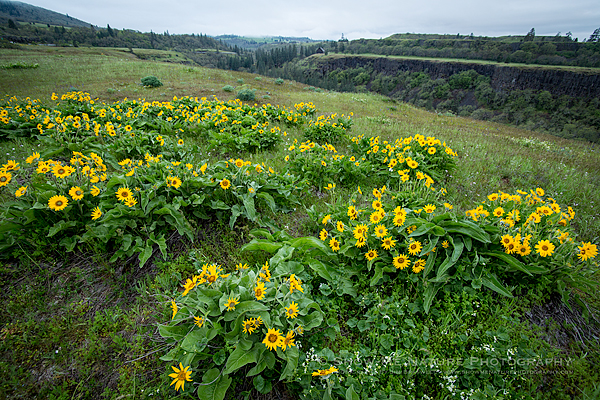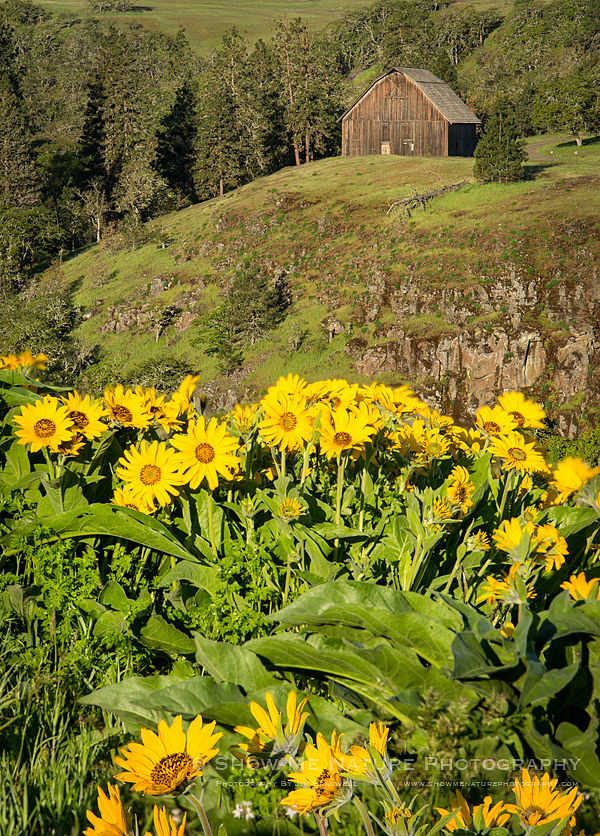Ever been out shooting and not quite sure which lens to use? Today’s post, captured during my recent Columbia Gorge trip (Oregon) is a good example of how different lenses can dramatically change the image you capture. During my second visit to the Rowena Plateau area of the Tom McCall Nature Preserve, I decided to “travel light” as I hiked, and to venture into an area I had not checked out on my first visit to the area. So I only took my macro lens and my wide angle lens with me.
After shooting for a couple of hours, I was quite a ways from the car (where I left the other lenses), when I came upon a landscape scenic that I desperately wanted to capture: a beautiful patch of Balsamroot wildflowers in the foreground, and an old wooden barn in the background. I immediately realized that my 70-200mm, f/2.8 lens would have been my lens of choice with the scene in front of me. But it was in the car. Since it was a little too far to go back for the 70-200 lens, I decided to shoot with the wide angle lens and see what I could get. Here is my favorite image with the wide angle lens:
Unfortunately, you can’t even see the barn in this image, unless you really strain your eyes! Do you see it? It is about in the center of the image (left-to-right), and on top of the little plateau that comes from the right. Nothing like I envisioned capturing when I saw the scene before my eyes!
A couple of days later, as I was starting my return trip home, I decided to stop here once more (it was only 6 miles off my route home) and try the 70-200mm lens. Arriving right before sunrise, I shot some images of the sunrise (I’ll post on these later). When the sun was overhead, I hiked to the area that contained the barn. Setting up my tripod at the same location, here is the image I captured with the telephoto lens:
Definitely more like I envisioned capturing on my previous trip! And the barn becomes an important part of the image. This image also points out an important factor of shooting landscapes with a telephoto lens. The telephoto lens gives us a nice, compressed look. This compression impacts this image in a couple of ways. First, it compresses the balsamroot wildflower patch into a much larger-looking patch of wildflowers. Second, the area between the flowers and barn is greatly compressed, making the barn much more an active part of this image. And if you are shooting in a mountainous location, where several distinct “layers” of mountains can be seen, the compression of these layers can be quite dramatic.
So the question arises, “Why not take the telephoto lens with me the first time?” Well, the answer to that is weight. As I age, carrying around camera gear is becoming more difficult, especially when hiking uneven ground, and I constantly work at finding ways to lighten the load. In this instance, it just wasn’t a good choice. But at least I had an opportunity to return with the telephoto lens at a later date!
Photographic Equipment Used:
- Canon 5D Mark III body (both images)
- Tamron 17-35mm, f/2.8 lens, and Canon 70-200mm, f/2.8 IS lens
- Bogen 3221 tripod with ballhead
- ISO 400 (wide angle image) and ISO 100 (telephoto image)
- Aperture f/11 (wide angle image) and Aperture f/22 (telephoto image)
- Shutter 1/4 sec. (wide angle image) and Shutter 1/45 sec. (telephoto image)
- Wide angle image shot at 17mm; Telephoto image shot at 200mm
- The telephoto image is actually a focus-stacked image, using 3 images combined into one (to assure sharp DOF throughout image)











